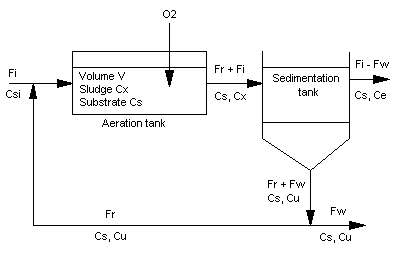
Since 1 December 1970 drain off of process water without permission has been forbidden in the Netherlands. Besides it has been made obligatory to take samples of the effluent at regular intervals. The quality of the effluent is mostly given by it's COD (chemical oxygen demand) and it's BOD (biological oxygen demand). These two parameters give an indication of the oxygen needed to degrade the organic pollution in the effluent.
To improve the quality of the effluent of the plant of Arco in Rotterdam a bio-plant has been build in 1976. In this bio-plant the water is cleared in an aeration tank (6000 m3) by activated sludge (biomass). In 1990 a second aeration tank of 8000 m3 has been added to the bio-plant.
After some simplifications (e.q. assuming the aeration tank is a CSTR type reactor, the substrate degradation can be described by Michaelis-Menten or Monod kinetics, etc.) it's possible to describe a bio-plant by a system of only four equations. By using these equations the effluent COD can be predicted for given conditions. The four equations meant are: substrate degradation, sludge production, total mass balance and the sludge balance (see figure).

The obtained model has been programmed into a spreadsheet and some macro's have been added to make the worksheet menu-controlled. Michaelies-Menten constants have been determined by interpreting laboratorium experiments and data from the process computer. Finally the predictions of the program have been compared with the measurements of the effluent of the real bio-plant and the results seemed to be very accurate.
The program can be used to predict the optimal distribution of the influent between both aeration tanks. Another interesting result is that quick estimates made with the worksheet showed that it would be interesting to investigate the possibility of placing both aeration tanks serial instead of parallel.